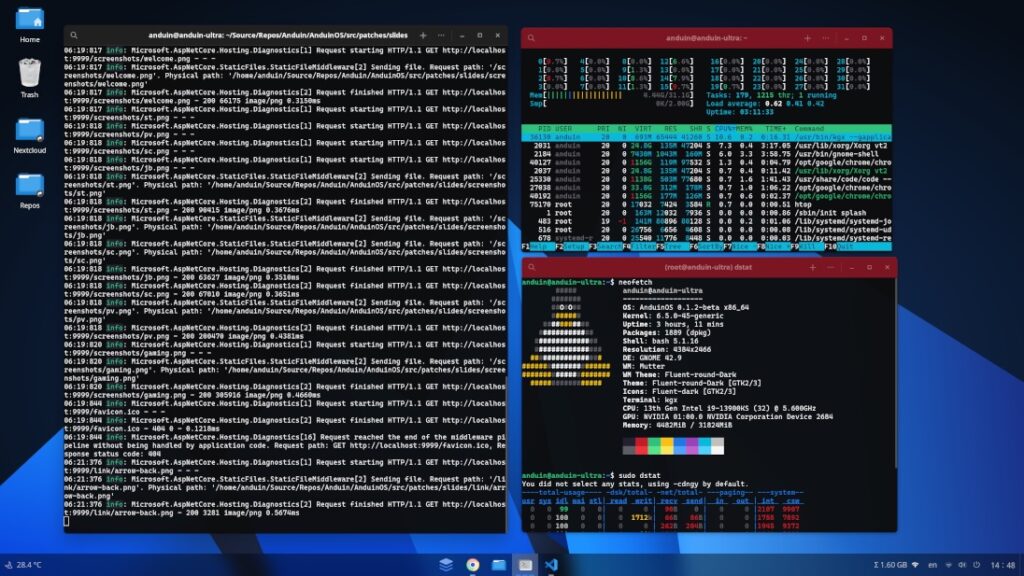The Linux world welcomes AnduinOS, a Debian-based distribution designed to provide an accessible, functional, and familiar experience, especially for users transitioning from Windows. AnduinOS 1.0 officially launched on September 1, 2024, following months of intensive development and thorough testing.
The Origin of AnduinOS: From a Script to a Complete Distribution
AnduinOS began as a simple idea: a script to efficiently initialize Windows systems. Over time, this concept evolved into creating customized Linux configurations and eventually into a fully-fledged operating system. Inspired by distributions like Arch Linux and NixOS, the project’s creator embraced the challenge of building a system from scratch, combining Debian tools with Ubuntu components to leverage the stability and popularity of its package ecosystem.
Unlike other distributions, AnduinOS prioritizes a simplified installation process and ease of daily use. Its design aims to balance Linux’s flexibility with the familiarity of Windows, making the transition smoother for new users.
A Simplified Installation Process
One of AnduinOS’s key features is its installer. Drawing inspiration from Windows’ ease of installation, the installer uses a decompression method similar to Windows’ WIM files. The preconfigured system, packaged in a single squashfs file, is directly extracted onto the disk during installation. This allows for quick and efficient setup, avoiding the complex manual steps typically required in other Linux distributions.
The installer guides users through the initial setup, including language selection, time zone configuration, passwords, and partitions, significantly reducing the learning curve.
Windows-Inspired Design and Functionality
AnduinOS’s interface is intentionally similar to Windows 11. With a focus on ergonomics and usability, the system uses GNOME as its base, extensively modified with numerous patches to replicate key design elements of Windows. This includes a persistent taskbar, quick access to important settings, and the absence of a top panel, facilitating navigation and application management.
The goal is to offer an intuitive experience that combines the best of both worlds: the power and flexibility of Linux with the familiarity of Windows.
A Minimalist Yet Effective App Store
Although AnduinOS does not yet feature a fully functional app store, it provides a web index with installation methods for various applications. This approach allows users to choose between multiple package managers, such as Snap, Flatpak, AppImage, and Apt, according to their preferences. This decision reflects a pragmatic approach: empowering users to manage their applications in the way they find most convenient, rather than imposing a single method.
Technical Features and Underlying Architecture
AnduinOS is built on principles of modularity and efficiency. Some technical highlights include:
- Debian-based with Ubuntu compatibility: It leverages Debian’s stability and Ubuntu’s extensive package repository, ensuring a robust and up-to-date ecosystem.
- Modular architecture: It enables the replacement or updating of individual system components without requiring a reboot, minimizing downtime.
- Automated installation: Utilizes chroot tools and custom scripts to efficiently build the system from scratch.
- Hardware compatibility: Supports common architectures, including Intel, AMD, and ARM, along with standard peripherals such as keyboards, mice, and basic graphics cards.
Challenges and Lessons Learned in Development
The development of AnduinOS was not without its challenges. From designing a functional installer to ensuring hardware and software compatibility, the team encountered numerous technical hurdles. One of the biggest lessons was understanding the inherent complexity of creating an operating system and how seemingly simple solutions, like using squashfs, can introduce new complications that require creative problem-solving.
Additionally, the focus on user experience led to important decisions, such as integrating visual tools and adopting a design inspired by popular systems, ensuring that AnduinOS remains accessible to a broad audience.
A Project in Continuous Evolution
While AnduinOS 1.0 is now available and suitable for daily tasks, development continues. Future versions aim to include improvements to the app store, enhanced Secure Boot support, and performance optimization for older hardware. The team behind AnduinOS also seeks to expand its community of users and contributors, inviting everyone interested to test, contribute, and shape the future of this promising distribution.
AnduinOS is not just an operating system; it’s a new way to approach the Linux world, with accessible design, modern functionality, and a focus on simplicity that aims to democratize access to technological tools.

